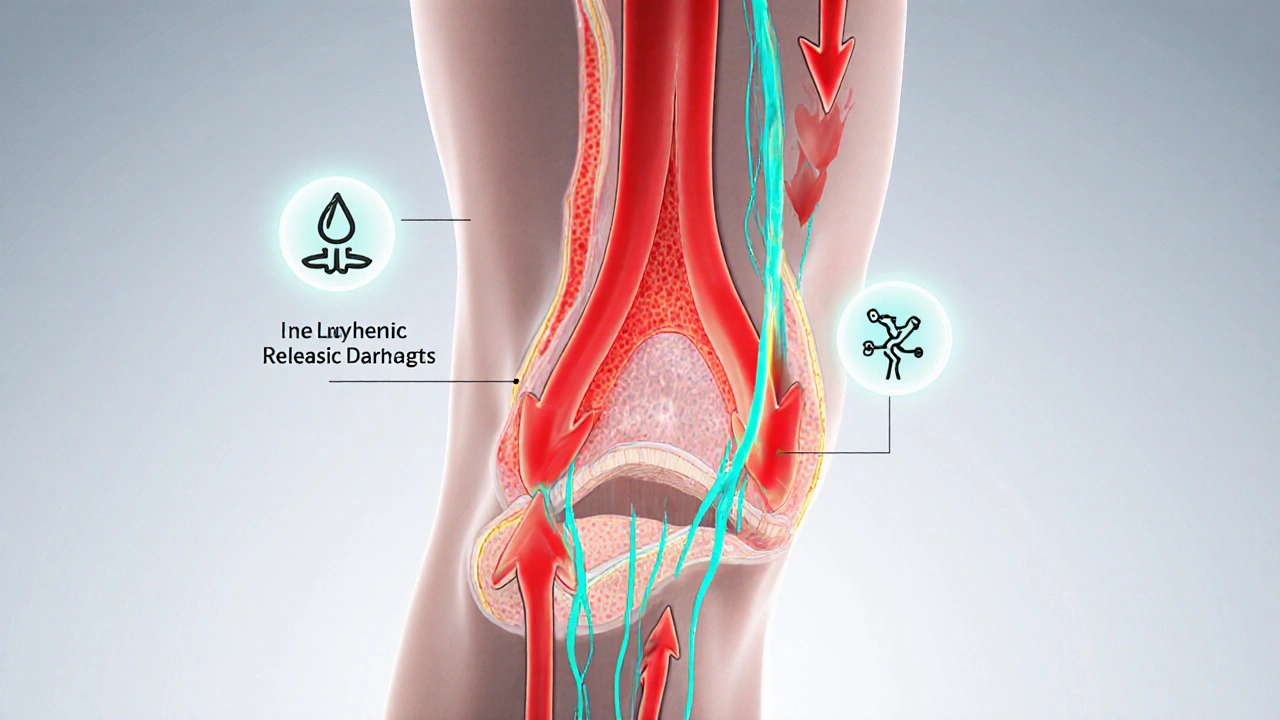Deep Tissue Massage Benefits: Boost Your Body’s Healing Naturally

Ever wonder why a deep tissue massage feels like a reset button for sore muscles and achy joints? It’s not just the pressure - it’s a cascade of physiological reactions that kick‑start your body’s own repair mechanisms. Below we’ll break down how the technique works, what to expect during a session, and how to integrate it safely into your wellness routine.
What Exactly Is Deep Tissue Massage?
Deep Tissue Massage is a therapeutic massage style that targets the deeper layers of muscle and connective tissue, known as the fascia. Unlike lighter strokes of a Swedish massage, the therapist uses slow, firm pressure to reach the muscle fibers and trigger points that cause chronic pain.
Key Anatomical Targets
- Muscle Fibers are the individual strands that contract to produce movement. When they become over‑used or injured, they develop micro‑tears that feel tight and painful.
- Trigger Points are hyper‑irritable spots within a muscle knot that refer pain to other areas of the body.
- Myofascial Release refers to techniques that stretch and relax the fascia-the thin, tough tissue that encases muscles, bones, and organs.
How the Body Responds: The Healing Cascade
When deep pressure is applied, several systems kick into gear:
- Increased Blood Circulation: Compression pushes blood out of the capillaries; the release phase allows a rush of oxygen‑rich blood to flood the area, delivering nutrients and clearing metabolic waste.
- Lymphatic Flow improves as the gentle stretching of fascia opens pathways for lymph to drain excess fluid and inflammatory cells.
- Endorphins are released, acting as natural painkillers and mood elevators.
- Cortisol levels drop, reducing the body’s stress response and allowing tissue repair to proceed more efficiently.
Session Walk‑Through: What to Expect
A typical deep tissue session lasts 60‑90 minutes and follows a predictable flow:
- Consultation: The therapist asks about your medical history, pain zones, and activity level.
- Warm‑up: Light strokes warm the superficial muscles, preparing them for deeper work.
- Targeted Work: Using forearms, elbows, or knuckles, the therapist applies slow pressure on identified trigger points.
- Release Phase: Pressure is gradually eased, encouraging blood and lymph to return.
- Stretch & Advice: Gentle stretches may be added, and the therapist suggests post‑massage care (hydration, light movement).

Who Benefits Most?
Deep tissue massage shines for people dealing with:
- Chronic lower‑back or neck pain
- Sports‑related muscle strain
- Postural imbalances from desk work
- Fibromyalgia flare‑ups (when performed gently)
It’s less suitable for people with acute inflammation, open wounds, or recent fractures. Always check with a healthcare provider if you’re unsure.
Comparing Popular Massage Types
| Feature | Deep Tissue | Swedish | Sports |
|---|---|---|---|
| Primary Goal | Release chronic muscle tension | Relaxation and circulation | Prepare/rehab for athletic performance |
| Pressure Level | Firm, focused | Light to medium | Variable - can be firm |
| Typical Session Length | 60-90min | 45-60min | 30-60min |
| Best For | Chronic pain, post‑injury | Stress relief, general wellness | Athletes, active individuals |
| Contraindications | Acute inflammation, blood clots | None major | Open wounds, recent surgery |
DIY After‑Care Tips to Maximize Healing
- Hydrate: Drink at least 2liters of water within the next few hours to help flush toxins released from the muscles.
- Gentle Movement: Light stretching or a short walk keeps blood flowing and prevents stiffness.
- Heat Therapy: Applying a warm pack for 10‑15minutes can further relax tightened fibers.
- Protein Intake: Consuming a protein‑rich snack supports muscle repair (e.g., Greek yogurt, nuts).
- Rest: Give your body 24‑48hours before intense workouts.

Potential Risks and How to Avoid Them
When done correctly, deep tissue massage is safe, but a few pitfalls can turn relief into discomfort:
- Excessive Pressure: If the therapist squeezes too hard, you may experience bruising or spikes in pain. Speak up; a good therapist adjusts intensity.
- Improper Timing: Scheduling a session right before a marathon can leave muscles feeling sore. Aim for at least 48hours before a major event.
- Underlying Conditions: Conditions like deep vein thrombosis, severe osteoporosis, or uncontrolled hypertension require medical clearance.
Finding a Qualified Therapist
Not every practitioner is created equal. Look for these credentials:
- Certificate from a reputable massage school (e.g., Australian College of Massage Therapy).
- Specialized training in deep tissue techniques.
- Positive client reviews mentioning relief from chronic pain.
- Membership in a professional body such as the Massage Association of Australia.
In Melbourne, many clinics offer a free initial consultation - use that to gauge comfort level and communication style.
Integrating Deep Tissue into a Holistic Wellness Plan
Think of deep tissue as one piece of a larger puzzle. Combine it with:
- Regular Exercise: Strength training and mobility work keep muscles healthy.
- Nutrition: Anti‑inflammatory foods (berries, omega‑3 rich fish) reduce chronic soreness.
- Sleep: 7‑9hours nightly amplifies tissue repair.
- Stress Management: Meditation or breathing exercises keep cortisol low.
When these elements align, a single deep tissue session can accelerate recovery by weeks rather than months.
Frequently Asked Questions
How often should I get a deep tissue massage?
For most people, once every 2‑4weeks balances benefit and recovery. Athletes in heavy training may schedule every week, while chronic pain sufferers might start with weekly sessions and taper off as symptoms improve.
Is deep tissue massage painful?
It can feel uncomfortable when a therapist works on a tight knot, but it should never be sharp or unbearable. Communicating pressure levels helps keep the experience productive.
Can I get a deep tissue massage if I’m pregnant?
Pregnant clients should opt for a prenatal‑modified deep tissue approach, focusing on the back, shoulders, and hips with lighter pressure. Always inform the therapist about your stage of pregnancy.
What’s the difference between trigger point therapy and myofascial release?
Trigger point therapy zeroes in on specific hyper‑irritable spots within a muscle, while myofascial release works more broadly on the fascia surrounding multiple muscles. Both can be part of a deep tissue session.
Will I be sore after a session?
A mild ache lasting 24‑48hours is normal, similar to post‑workout soreness. It indicates tissue response. If pain spikes or lasts longer, contact your therapist.



Jodie Rae Plaut
October 16, 2025 AT 15:06Deep tissue massage operates on several physiological layers; it engages the mechanotransduction pathways within the fascia, prompting fibroblast realignment and collagen remodeling. The therapist’s sustained pressure triggers a neurovascular response, augmenting nitric oxide synthesis which vasodilates capillaries and improves perfusion. By compressing the interstitial matrix, lymphatic vessels are mechanically cleared, expediting the removal of metabolic waste such as lactate and prostaglandins. Endorphin release, mediated through μ‑opioid receptors, provides analgesia while simultaneously elevating mood via dopaminergic circuits. Reduced cortisol output, observed in multiple cortisol‑salivary studies, curtails the catabolic stress response, allowing anabolic processes to dominate tissue repair. Myofascial release, a key component of deep tissue work, stretches the epimysial layers, decreasing shear strain and restoring optimal sarcomere length. Trigger point desensitization interrupts the nociceptive feedback loop, preventing central sensitization and chronic pain amplification. The cumulative effect is a systemic homeostatic shift that supports both micro‑ and macro‑recovery pathways. For athletes, this translates to decreased delayed‑onset muscle soreness and enhanced proprioceptive acuity. Office workers report improved postural alignment after a series of sessions, likely due to the reduction of maladaptive myofascial adhesions. Nutrition-wise, pairing the massage with adequate protein intake supplies the amino acids necessary for muscle protein synthesis during the reparative window. Hydration further facilitates lymphatic transport, ensuring that inflammatory cytokines are efficiently cleared. Light movement post‑session, such as dynamic stretching, maintains the newly mobilized fascial planes and prevents re‑stiffening. Sleep, the ultimate regenerative state, synergizes with the massage‑induced hormonal milieu to accelerate collagen cross‑linking. In essence, deep tissue massage acts as a catalyst that orchestrates vascular, neural, and biochemical systems toward optimal healing.
Colin Napier
October 16, 2025 AT 16:30Okay, here’s how you can tell if your therapist is truly trained for deep tissue work: they’ll start with a thorough intake, ask about chronic conditions, note any contraindications, then they’ll use slow, firm strokes that feel like a deep stretch, not just a gentle rub; you’ll feel the pressure building gradually, you’ll notice a warm rush of blood after the release phase, and you’ll probably end the session feeling a little sore, which is totally normal, just remember to speak up if it ever feels like a hammer – communication is key, and hydrate afterwards, because your cells will thank you for the flush.
Patsy Ferreira
October 16, 2025 AT 17:53Honestly, the article sounds impressive, but there are a few red flags; first, the claim about “collagen remodeling” after a single session is scientifically shaky, most studies show only transient changes, not long‑term structural alterations; second, the suggestion to “pair the massage with adequate protein intake” is vague – how much protein? 20g? 40g? – without specifics the advice is useless; also, the statement that “endormin release” provides analgesia is a mis‑spelling, it should be “endorphin”; overall, while deep tissue can be beneficial, the piece overstates the evidence and definitely needs more nuance.
William Terry
October 16, 2025 AT 19:16Sounds like a solid routine for anyone dealing with chronic tension.
Peter Jones
October 16, 2025 AT 20:40The intake process you described aligns with best‑practice guidelines from the American Massage Therapy Association; a detailed health history not only safeguards against contraindications but also informs the therapist’s selection of pressure levels and targeting strategies. Moreover, emphasizing post‑session hydration is backed by lymphatic physiology, as water facilitates the transport of interstitial fluid. It’s also worth noting that the mild soreness you mentioned is akin to post‑exercise DOMS, which typically resolves within 48 hours.
Theophilus Twaambo
October 16, 2025 AT 22:03While you raise valid concerns, let’s correct a few inaccuracies: the phrase “collagen remodeling” is not entirely incorrect – mechanotransduction can stimulate fibroblast activity, which does influence collagen turnover, albeit gradually; the protein recommendation should be quantified, for example 0.25‑0.3 g per kg of body weight post‑massage, which clears up the ambiguity you noted; also, the term “endormin” is a typographical error, the correct term is “endorphin”, and finally, the article’s claim about “transient changes” could be better phrased as “short‑term physiological responses”, which maintains scientific precision.